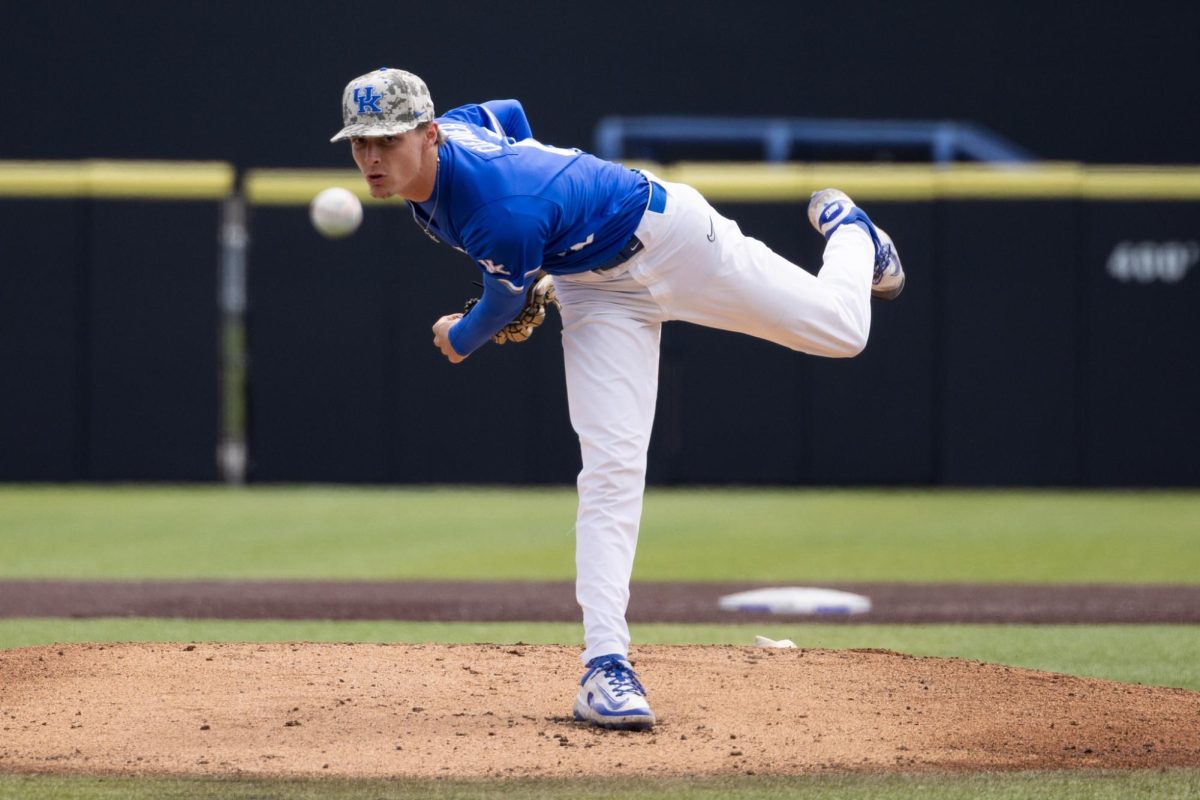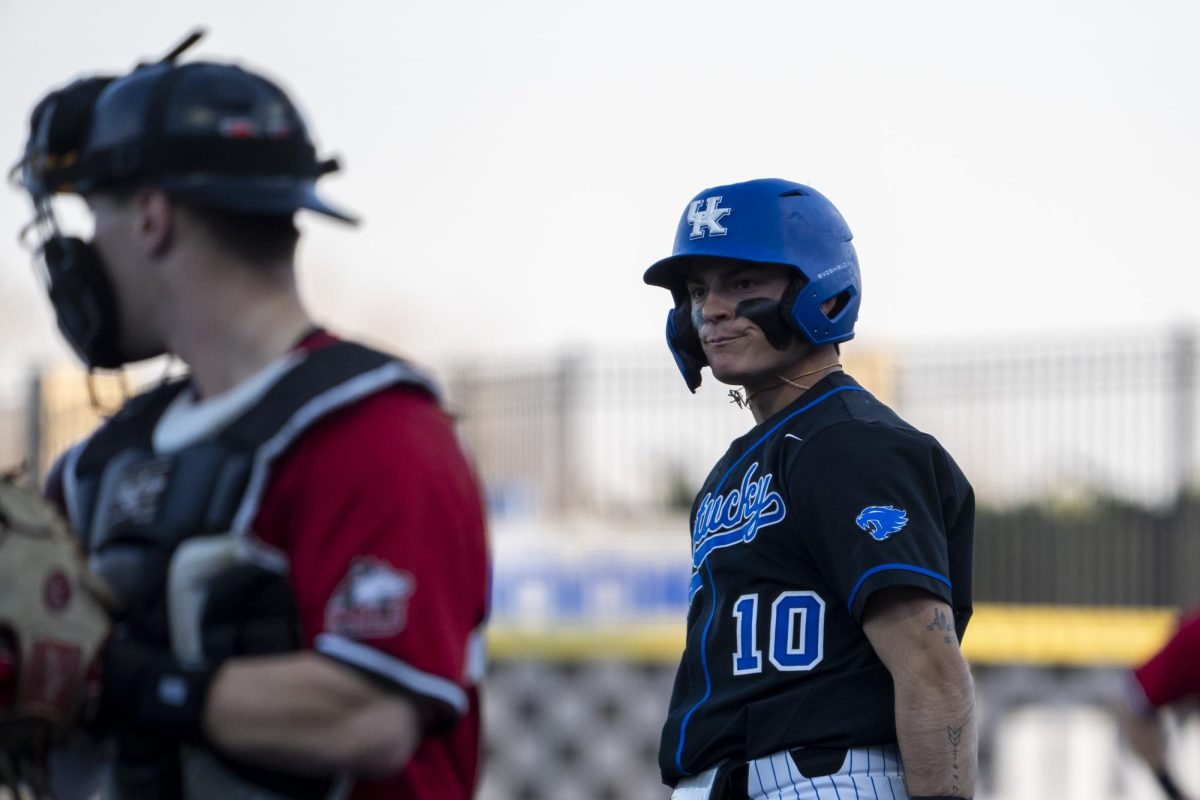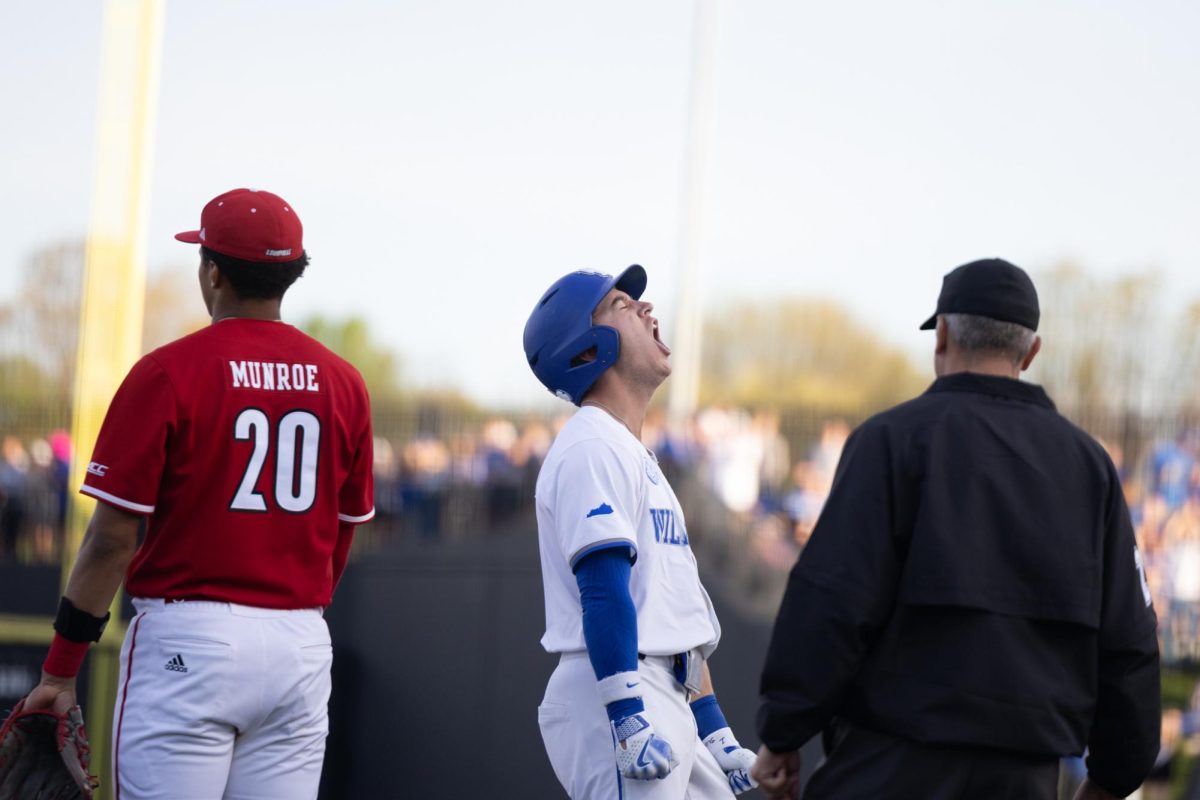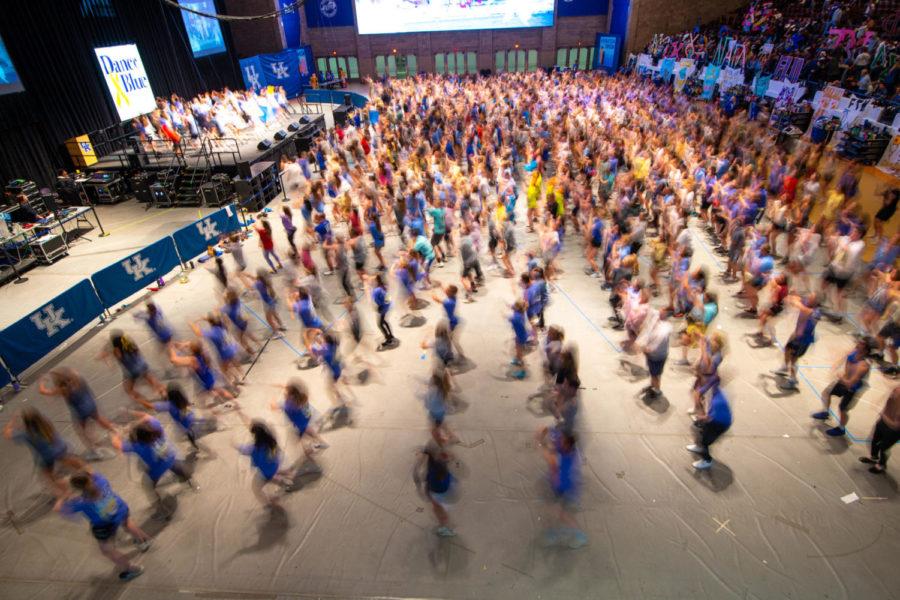Format changes but spirit remains for beloved fundraiser
March 22, 2021
The scene is almost unimaginable now: hundreds of University of Kentucky students in close proximity in one room, sweating together, laughing together, crying together. Not only do they not shirk from each other’s touch, they actively embrace it, coming together for support, comfort and a helping hand. These are the hallmark scenes of a DanceBlue marathon, but scenes that this year at least will exist only in memory, not practice.
For 15 years, DanceBlue has hosted an annual 24-hour dance marathon to cap off a year of fundraising for pediatric cancer and its eponymous clinic at UK’s Markey Cancer Center. In those fifteen years, the organization grew, evolved and changed, but its sixteenth iteration will be unlike all the rest – held virtually because of the COVID-19 pandemic.
The 2021 marathon will be held on April 10. Shortened to eight hours, this year’s version will incorporate the most beloved and iconic traditions of years past, including the memorial hour, where the families of patients who died from pediatric cancer speak in honor of their loved ones. Programming chair Morgan Thurza, who planned the marathon, emphasized that those traditions will still happen, albeit a bit differently.
“We’re still going to have the themed hours and activities that go along with them. We’re still going to have the line dance and it’ll be taught and done at the top of every hour,” Thurza said.
The truncated marathon will begin at 11 a.m. on April 10 and be livestreamed for spectators. For the first two hours, participants will learn the line dance. From 1 p.m. to 4:30 p.m., dancers will split into Zoom and Google rooms for themed activities and games. After a dinner break, programming will resume at 6 p.m. and the final two hours will be dedicated to traditions like the patient talent show, family speakers and the fundraising total reveal.
The virtual format was not set in stone until January of 2021; up until then, DanceBlue leaders hoped to include some kind of in-person aspect to uphold tradition.
“I think like everyone else, I thought there was no way that we were still going to be living in a COVID world come spring, which obviously is not the case,” Thurza said.
By this school year, DanceBlue leaders knew that the marathon would not be normal, but tried to keep the in-person marathon while following COVID-19 protocols. The later date, April instead of March, arose in part because of hopes that vaccine rollout would enable normalcy to the point where an in-person marathon was possible.
“When it came down to it, we just thought about our one goal and to get back to our roots of what we stand for as an organization and made the decision to go with a virtual format, just because it was the best way to protect and keep all those within our community as safe as possible,” Thurza said. Ideas like splitting dancers into shifts were scrapped because of logistical challenges, despite the team at first being set on an in-person marathon.
“It just started to become super overwhelming and it just kind of felt like we were losing the spirit and meaning behind DanceBlue, just for the sole purpose of an in-person component to the marathon,” Thurza said. When December rolled around and COVID-19 was very much present, Thurza and co. realized the best option was still to go virtual.
For DanceBlue organizers, a virtual marathon means saying goodbye to a chapter of their college experience. Senior Allie Holt is DanceBlue’s 2021 overall chair and has been involved with the organization since high school. She said coming to terms with the virtual format was a ‘perspective shift.’
“I definitely had to process things, and realize like, ‘Oh, that really stinks.’ l’ve been looking forward to my senior marathon for four years now and that sort of thing, but at the end of the day, DanceBlue is not all about the marathon,” Holt said. “DanceBlue is about the kids and the families and the money we raised for them.”
Other committee chairs echoed similar thoughts, saying one way the organization coped with the challenges of the pandemic was by grounding themselves in their core mission.
“The world was changing around us and there’s so much uncertainty and there’s so much unknown, but DanceBlue is very certain,” Thurza said. “We always have our one goal of working for the kids and knowing that we still had that piece in our life like it didn’t ever make it feel like it wasn’t normal.”
The old way
The 2020 DanceBlue marathon was seemingly normal, with more than 900 students on the floor of Memorial Coliseum and a couple thousand spectators in the stands. Only in retrospect does the marathon look like the close call it actually was.
“I think we probably would have gotten a phone call from the health department, just because of the number of people we had,” said Sally Martin, last year’s overall DanceBlue chair. Held on March 1, the mass gathering was one of the last normal occurrences on UK’s campus. Five days later, Kentucky had its first case of COVID-19 and DanceBlue transitioned to virtual meetings to select the chairs for the 2021 committees.
Martin said there was a possibility DanceBlue would have been held the weekend that COVID-19 shutdowns started but kept the earlier date because of Daylight Savings Time.
“Northwestern University was hosting their dance marathon that weekend, and they ended up canceling it that weekend, and I remember our group so with our cheer team and our advisors, we were like, ‘Man, y’all, if we were worried – a week later, we would have probably had to cancel too.’”
But UK’s marathon snuck in under the wire, before many Americans were concerned about the virus. Martin recalls having extra hand sanitizer available.
“[One of our advisors] had said, ‘are there any precautions that you all are thinking about taking in case there’s a case in Kentucky’ and we’re like, ‘that’s never gonna happen,’” Martin said. DanceBlue did see an increase in last minute drop-outs from the marathon due to unknown sickness compared to previous years.
“I don’t really think any of those could have been a COVID case, but it’s just interesting to think about that people weren’t there,” Martin said.
Holt recalls the marathon with fondness but is flabbergasted by it now.
“I look back at those pictures, and, like, what the heck,” Holt said. “There are no masks inside, there’s so many people everywhere. What were we doing? But then I was like, ‘oh wait, that was normal life.’”
“It could have been a super spreader event,” Dr. John D’Orazio jested, before recalling the inspirational milestone of $2 million hit in 2020. Carrying the momentum of that milestone with them made a difference to this year’s committee chairs, who transitioned into their new roles virtually. An adviser pointed out to Martin the responsibility DanceBlue had in this new age.
“She’s like, ‘we’re transforming to a whole new college experience, and because you guys are one of the big three, big four for student organizations on campus, part of your mission has to change too,’” Martin said. “Just serve students better, like how do we involve students more, how are we more inclusive being virtual.”
Finances not the focus
Since its founding, DanceBlue has raised more than $17 million for pediatric cancer care and research. Each year’s total has superseded the prior year, culminating in 2020 when organization broke $2 million in annual donations for the first time. But the overwhelming need and philanthropic efforts generated by the pandemic and natural disasters in the last 12 months has DanceBlue facing the very real prospect that their fundraising total will drop.
“So as of right now, it is looking a little bit less than we have in the past years, and most of that is due to COVID,” fundraising chair Lizze Rupp said of funds at this point in the semester. Rupp oversees internal, external, alumni, corporate and team fundraising. She thinks personal fundraising has taken the biggest hit this year.
“Especially with a lot of our recurring dancers, they have people that do donate to their total every year and maybe those people are not able to donate this year or in this capacity as in years past,” Rupp said. But that has paved the way for more creative fundraising like bracelets and merchandise.
Holt noted that every overall chair feels pressure to continue the streak of raising the total annually, but that it’s not her main focus.
“We have to realize however much that is, it’s still going to help these families and these kids that are going through something so terrible. No matter what the amount is, or if it goes beyond the last years or not, it’s, it’s still an amount that is so amazing,” Holt said.
Rupp suggested people who cannot contribute financially can help support DanceBlue by resharing their posts about pediatric cancer.
“It’s about supporting the kids and a big portion of that is monetary support and economic support, but also just promoting awareness for pediatric cancer and for the work that the clinic is doing and the work that they’re doing in terms of pediatric research,” Rupp said. Donations are accepted through 3:30 p.m. on the day of the marathon, April 10.
Clinic leaders like John D’Orazio understand the financial strain of the last year will impact DanceBlue.
“With the economy and stuff, philanthropy in general has been taking a big hit. We’re gonna be grateful for whatever comes in and we’re going to use it to benefit the children,” D’Orazio said. “We are fortunate that we do have some money in the bank, so to speak.”
D’Orazio is chief of UK’s pediatric hematology/oncology clinic. He explained that traditionally, a third of the money has gone to pediatric cancer research, a third to holistic care like social workers and school specialists and a third directly to families for care-related costs like travel. With the money from DanceBlue, the center will soon introduce a germline DNA testing program to evaluate genetic risks that would predispose patients to cancer. That kind of testing can help doctors tailor a patient’s care plan to their specific needs, but also screen their siblings.
“When the first child had his or her or their cancer, then you can test based on the family’s wishes of course, the other members of the family and if another child or a parent is identified, get them appropriately referred to a specialist,” D’Orazio said. He noted that part of the reason DanceBlue has gone on for so long is that the funds haven’t been abused and everybody involved walks away with a win.
“It’s just such a great, great optimistic program and in today’s world, there’s not anything you can say that has all positives and very little or no negatives,” D’Orazio said.
In every cloud
The financial hit from COVID-19 extended to DanceBlue’s annual fundraisers. Two of the biggest events are the 5K and silent auction, both held in the fall. Both were virtual this fundraising cycle, which came with an unexpected benefit.
“We were able to reach people literally across the country, so alumni or families or parents or committee members,” Holt said. “We were able to reach all those people all over, versus in the past we’ve only been able to reach the people that buy the silent auction ticket and come to the silent auction.”
Holt mentioned one alum, who lives in California, that runs the 5k annually on his own and had never registered for the official event until this year because of the virtual format. Though the number of runners decreased, the range increased, with more and more participants joining from out of state. And, DanceBlue saved money on both events by reducing overhead costs.
“It was honestly better financially to have an online platform versus getting a space in-person, getting food, all those little like extra in-person fees which are great for an in-person event,” Holt said.
Extra accessibility because of a virtual format will extend to the number of dancers in the marathon. Last year, the marathon had 923 students on the floor, who earned their spots by being the top earners for their teams. But the virtual format will up that number.
“It usually is very competitive for that floor space,” Holt said. “And so, we will have a little bit more wiggle room this year. However, we are limited by some virtual restrictions still.”
She expects DanceBlue to have more than 1,000 dancers this year but does not have an exact upper limit yet. Though technology will still limit participants, holt said the livestream for spectators will have unlimited capacity, whereas Memorial Coliseum usually maxed out in-person attendees at around 2,500.
Another significant source of fundraising are mini marathons hosted by different schools and organizations across the state. Normally, 40 mini marathons are hosted annually, but with varying COVID-19 restrictions that number dropped.
“There have been some high schools and middle schools that have been absolute rock stars and found ways to fundraise,” Holt said, including a Lexington school that hosted a 5k and bake sale.
Clinic operation
DanceBlue fundraises for the pediatric side of Markey Cancer Center, and for years has funded not only medical but holistic services for the clinic. The hustle and bustle, friendly atmosphere and student volunteers were all affected by COVID-19.
“Our clinic used to be a place where families would come together, we would have dance food students and volunteers, we’d have learners and observers and dogs, therapy dogs and music people, and it was just a great village, basically,” D’Orazio. Because of the pandemic, they have introduced more telemedicine, shut down learners and limited families to one caregiver, essentially eliminating visitors.
Cancer patients are immunocompromised in part due to their treatments, meaning they are more susceptible to illnesses like COVID-19. D’Orazio has said the clinic has taken that warning to heart in order to protect their patients.
“We have had a couple kids get COVID-19. And thank goodness, nobody’s died from it in our population. Thank goodness for that,” D’Orazio said. “We haven’t had that many, and that’s another thank goodness.”
As D’Orazio explained, children – even children with cancer – are not as affected by COVID-19 as adults are, but he would prefer not to take any chances. Kristina Richetts, child life specialist at the DanceBlue clinic, said the Markey Center’s robust psycho-social team has been able to mitigate some of the effects of isolation on the young patients.
“Our kids really are missing their peers in the school setting the most, but through dance boy we have been able to have monthly virtual events,” Richetts said, with 15 – 20 patients and their siblings participating in those monthly parties. She said the center’s school intervention specialist has attended countless Zoom meetings to keep patients engaged with schools and that overall quality of care has remained the same, just some done remotely.
Child cancer patients used to get social interaction from DanceBlue’s clinic volunteers, UK students who came to the clinic to keep the patients’ company. Family relations chair Emily Huette oversees those volunteers, who stopped going into the clinic shortly after last year’s marathon. She said that having to make the decision to go into the clinic was hard, but the best decision they could have made.
Where in previous years DanceBlue volunteers physically played board games, watched movies and the like with patients, Huette said those hours have been replaced with virtual bingo, pen pals and Zoom parties.
“With the pen pals, we get to keep our letters from the kids. And that’s special to me because I have a friendship with my pen pal now and so it’s really great to have something like that and something tangible that I can keep with me throughout the year,” Holt said.
The first virtual event Huette hosted was a Halloween party (“DanceBoo”), and she was nervous that the kids wouldn’t show up or have a good time.
“The sweetest thing was at the end we had a little boy,” Huette recounted. “And he was like, ‘I don’t want to leave yet. I don’t want the party to end yet.’ And so we stayed on and him and his mom talked to us for a few minutes.”
Like fundraising events, virtual interactions have let the family relations committee reach patients from farther away.
“We’ve been able to touch families who live farther away because in the past, if we had a weekend party, a parent might not be able to spend the day to drive to Lexington to come to that additional party,” Huette said.
Thurza said the pandemic gave her extra motivation towards working on the marathon because it has been a small taste of what the clinic families go through on a daily basis.
“They knew what isolation meant before we ever had to do it. And so just knowing that we’ve been able to adapt everything that we do for the most part, traditionally in the past to today’s times, to still be there for the families, that is the most like rewarding and heartwarming thing ever,” Thurza said. “Obviously like some days are hard but so are the kids’ days.”
Martin recounted a similar lesson from a former DanceBlue chair, who said these kids wear masks all day for years.
“If we wear a mask for a year, we’re just showing them that we’re supporting them in that same way,” Martin said. “And so I think that the spirit of DanceBlue was never been about the money, it’s just been about helping others, and this year especially, you can help others virtually.”
Planning for the unknown
Not only has the marathon changed, but the process behind it has as well. The transition notes and recommended timelines from the previous DanceBlue chair were not applicable to Holt’s situation.
“Nobody knew what we were getting ourselves into exactly and what the year would look like and so of course I have been stressed out about it and things because I want to serve these kids as best as I can,” Holt said. “However, everybody’s kind of in the same boat right now and has been for the past year.”
One change has been a move to online meetings and stopping office hours. Holt said they have a virtual option for every meeting and by spring were meeting online almost exclusively.
“I think that has made us better communicators in a lot of ways,” Rupp said. “We’ve learned to be definitely more specific and really utilize our time as well because we don’t see each other all the time like we would have in a normal year when we could all be in the office.”
Holt said she thinks some virtual aspects will continue to expand accessibility, like they saw this year with the 5K and silent auction.
“Giving the opportunity to those people that aren’t in central Kentucky is something that I find really special and something that would be really awesome to carry on,” Holt said. Being able to chart a new path is also exciting on for the committee chairs.
“We’ve never had a virtual fundraiser before, or virtual marathon so I’m excited to kind of try something completely new for my last go around and I’m really looking forward to it,” Rupp said. Though DanceBlue as a whole did not decide on a virtual marathon until four or five months ago, Rupp knew as far back as last May that she would have to adjust to COVID-19 and incorporated that into her summer planning.
“This organization will never stop fighting for these kids, even during a global pandemic. So, I’m excited for everyone to see how we have been able to rewrite DanceBlue despite the circumstances of the world this year,” Holt said. Along with getting back to DanceBlue’s roots, chairs said they had a mindset shift of seeing every part of this year as special because of how hard they worked to adapt.
“I’m just, I’m thankful that we have modern day technology that we can have a marathon and so I’m excited for it,” Huette said. “I’ve been so blessed to have three in person marathons, and I think this one is going to be special in its own way.”
Hoping forward
As the marathon approaches, the clinic is prepared to fully participate in the festivities.
“We have some really special marathon boxes that we’ll be sending out that will include the marathon t-shirts, they’ll have crafts, they’ll have decorations so that they can celebrate at home and we will have two live Zoom events that patients and families can participate in,” said Richetts. Because patients enjoy the talent show the most, the clinic will host a virtual talent show and record the patients’ performances for the marathon.
“We waited a long time to hear what the plans were going to be for the marathon, and I think we were just over the moon that there was still going to be one,” Richetts said. “One of our biggest fears is that we wouldn’t be able to have one in any capacity.” She hopes the sense of togetherness and support still shines through in the virtual format.
Even though the marathon continues, D’Orazio noted he will miss the live event.
“That live event is the most inspirational thing I go to all year, okay,” D’Orazio said. “I go in that gym, it’s full up with students who are devoted to these kids, stands have gotten fuller and fuller,” with patients and their families reuniting with clinic staff. Richetts said the last four hours of the marathon, when the memorial hour and reveal happen, are the most impactful for the clinic and families. Those traditions will continue virtually with pre-recorded speeches from families.
“It’s fine if we have to do these other things for a year, we’re going to make the best of it and Christina and her team needs to be really you know praised for all those efforts, but I’m going to miss the live event because I don’t come out of there without tears coming out of my eyes,” D’Orazio said.
Rupp said her favorite part of the marathon is the reveal, but that this year she thinks there won’t be one big moment like that.
“It’s been a lot of little victories along the way that really made a difference,” Rupp said.
Thurza, Huette and Holt reminisced on their marathon memories, feeling lucky to have had those experiences already and most importantly be able to continue working for the kids.
“During this pandemic, a lot of things in the world stopped just because we were forced to,” Holt said. “However, that list of things does not include cancer, and if anything, patients with cancer are even in more need than ever before.”
Virtual or not, there will still be dancing, there will still be a marathon and there will still be students volunteering to make a difference. To those closest to DanceBlue, that spirit is more important than any dollar amount or in-person activity.
“This one’s going to be different, but who says it can’t be still something very meaningful?” D’Orazio said. “So we’re making the best of it, and with an eye on the future.”




























































































































































